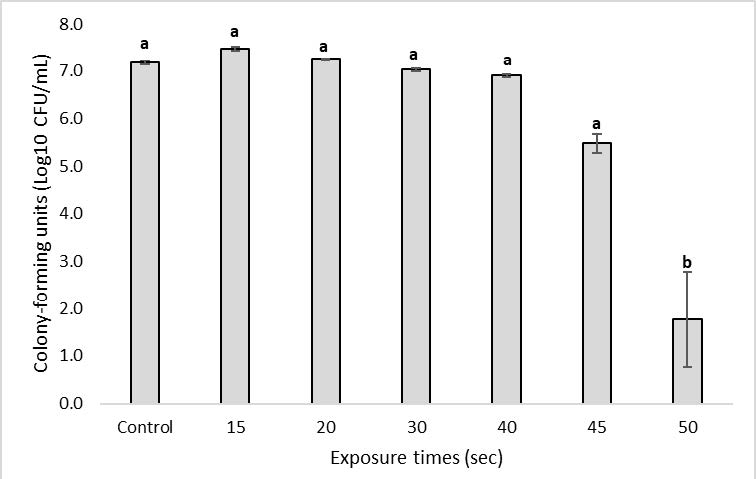Effects of Microwave Electromagnetic Radiation on Milk Microbiology and Physicochemical Properties
Efectos de la Radiación Electromagnética de Microondas en la Microbiología y las Propiedades Fisicoquímicas de la Leche
Barra lateral del artículo

Términos de la licencia (VER)

Esta obra está bajo una licencia internacional Creative Commons Atribución-NoComercial-SinDerivadas 4.0.
Declaración del copyright
Los autores ceden en exclusiva a la Universidad EIA, con facultad de cesión a terceros, todos los derechos de explotación que deriven de los trabajos que sean aceptados para su publicación en la Revista EIA, así como en cualquier producto derivados de la misma y, en particular, los de reproducción, distribución, comunicación pública (incluida la puesta a disposición interactiva) y transformación (incluidas la adaptación, la modificación y, en su caso, la traducción), para todas las modalidades de explotación (a título enunciativo y no limitativo: en formato papel, electrónico, on-line, soporte informático o audiovisual, así como en cualquier otro formato, incluso con finalidad promocional o publicitaria y/o para la realización de productos derivados), para un ámbito territorial mundial y para toda la duración legal de los derechos prevista en el vigente texto difundido de la Ley de Propiedad Intelectual. Esta cesión la realizarán los autores sin derecho a ningún tipo de remuneración o indemnización.
La autorización conferida a la Revista EIA estará vigente a partir de la fecha en que se incluye en el volumen y número respectivo en el Sistema Open Journal Systems de la Revista EIA, así como en las diferentes bases e índices de datos en que se encuentra indexada la publicación.
Todos los contenidos de la Revista EIA, están publicados bajo la Licencia Creative Commons Atribución-NoComercial-NoDerivativa 4.0 Internacional
Licencia
![]()
Esta obra está bajo una Licencia Creative Commons Atribución-NoComercial-NoDerivativa 4.0 Internacional
Contenido principal del artículo
Resumen
Conventional thermal treatments for milk processing in small and medium-sized enterprises (SMEs) often fail to fully meet Colombian food quality and safety regulations, particularly in microbial inactivation and nutrient preservation. In response, non-conventional thermal treatments, such as microwave heating, offer a promising alternative due to their ability to generate efficient volumetric heating and reduce processing times compared to traditional methods. This study evaluated the effects of microwave electromagnetic radiation on the microbiology and physicochemical properties of milk under different exposure times and power levels. In phase 1, a randomized experimental design was applied using a 1500 W microwave at 2450 MHz to treat 100 ml milk aliquots for different exposure times (0 to 50 seconds). In phase 2, a pilot-scale continuous flow system with an 18-liter capacity was developed, operating at 700 W and 1000 W with exposure times of 10, 15, and 20 seconds. Microbiological and physicochemical analyses demonstrated that treatment at 1000 W for 20 seconds met the standards of Decree 616 of 2006 and the Pasteurized Milk Ordinance (PMO), achieving significant microbial reduction without altering physicochemical properties such as fat, protein, and total solids content. In contrast, treatments at 700 W were ineffective for microbial inactivation, indicating the importance of using higher power levels. Additionally, the continuous flow system improved heat distribution, making the process more homogeneous and efficient. These findings suggest that the use of microwaves in continuous flow systems is a viable alternative for improving the microbiological quality of milk, optimizing its processing in SMEs through an efficient method with minimal impact on the final product composition while maintaining regulatory compliance.
Descargas
Detalles del artículo
Referencias (VER)
Angoy, A.; Brianceau, S.; Chabrier, F.; Ginisty, P.; Jomaa, W.; Rochas, J. F.; Sommier, A.; Valat, M. (2019). Microwave technology for food applications. Green Food Processing Techniques: Preservation, Transformation and Extraction, 455–498. https://doi.org/10.1016/B978-0-12-815353-6.00017-3
Bornhorst, E. R.; Liu, F.; Tang, J.; Sablani, S. S.; Barbosa-Cánovas, G. V. (2017). Food quality evaluation using model foods: A comparison study between microwave-assisted and conventional thermal pasteurization processes. Food and Bioprocess Technology, 10(7), 1248–1256. https://doi.org/10.1007/s11947-017-1900-9
Chandrasekaran, S.; Ramanathan, S.; Basak, T. (2013). Microwave food processing—A review. Food Research International, 52(1), 243–261. https://doi.org/10.1016/J.FOODRES.2013.02.033
Chen, Z.; Li, Y.; Wang, L.; Liu, S.; Wang, K.; Sun, J.; Xu, B. (2017). Evaluation of the possible non-thermal effect of microwave radiation on the inactivation of wheat germ lipase. Journal of Food Process Engineering, 40(4), e12506.
Feng, H.; Yin, Y.; Tang, J. (2012). Microwave drying of food and agricultural materials: Basics and heat and mass transfer modeling. Food Engineering Reviews, 4(2), 89–106. https://doi.org/10.1007/s12393-012-9048-x
Gautam, S. (2024). Enhancing food security, safety, and sustainability via the application of radiation technology BT. En D. K. Aswal (Ed.), Handbook on Radiation Environment, Volume 1: Sources, Applications and Policies (pp. 357–381). Springer Nature Singapore. https://doi.org/10.1007/978-981-97-2795-7_12
Guo, Q.; Sun, D. W.; Cheng, J. H.; Han, Z. (2017). Microwave processing techniques and their recent applications in the food industry. Trends in Food Science & Technology, 67, 236–247. https://doi.org/10.1016/J.TIFS.2017.07.007
Instituto Colombiano de Normas Técnicas y Certificación. (1996). NORMA TÉCNICA COLOMBIANA NTC 666. Leche y productos lácteos. Guía para muestreo (p. 43).
Instituto Colombiano de Normas Técnicas y Certificación. (2002). NORMA TÉCNICA COLOMBIANA NTC 399. Productos lácteos. Leche cruda (p. 10).
International Organization for Standardization (ISO); International Dairy Federation (IDF). (2006). ISO 13366-2:2006 — IDF 148-2:2006: Milk - Enumeration of somatic cells - Part 2: Guidance on the use of alternative methods. International Organization for Standardization.
Jiang, H.; Liu, Z.; Wang, S. (2018). Microwave processing: Effects and impacts on food components. Critical Reviews in Food Science and Nutrition, 58(14), 2476–2489.
Joshi, T. J.; Singh, S. M.; Rao, P. S. (2023). Novel thermal and non-thermal millet processing technologies: Advances and research trends. European Food Research and Technology, 249(5), 1149–1160. https://doi.org/10.1007/s00217-023-04227-8
Käferstein, F. K.; Moy, G. G. (1993). Public health aspects of food irradiation. Journal of Public Health Policy, 14(2), 149–163. https://doi.org/10.2307/3342961
Kapcsándi, V.; Cserpán, M.; Hanczné Lakatos, E. (2020). Impact assessment of microwave treatment of raw cow’s milk on its microbiological properties. Analecta Technica Szegedinensia, 14(2), 69–76. https://doi.org/10.14232/analecta.2020.2.69-76
Martins, C. P. C.; Cavalcanti, R. N.; Cardozo, T. S. F.; Couto, S. M.; Guimarães, J. T.; Balthazar, C. F.; Rocha, R. S.; Pimentel, T. C.; Freitas, M. Q.; Raices, R. S. L.; Silva, M. C.; Esmerino, E. A.; Granato, D.; Cruz, A. G. (2021). Effects of microwave heating on the chemical composition and bioactivity of orange juice-milk beverages. Food Chemistry, 345, 128746. https://doi.org/10.1016/J.FOODCHEM.2020.128746
Martins, C. P. C.; Cavalcanti, R. N.; Couto, S. M.; Moraes, J.; Esmerino, E. A.; Silva, M. C.; Raices, R. S. L.; Gut, J. A. W.; Ramaswamy, H. S.; Tadini, C. C.; Cruz, A. G. (2019). Microwave processing: Current background and effects on the physicochemical and microbiological aspects of dairy products. Comprehensive Reviews in Food Science and Food Safety, 18(1), 67–83. https://doi.org/10.1111/1541-4337.12409
Martins, C. P. de C. (2021). Processamento de orange juice-milk por micro-ondas [Tesis de maestría, Universidade Federal Rural do Rio de Janeiro].
MINISTERIO DE LA PROTECCIÓN SOCIAL. (2006). Decreto número 616 de 2006 (p. 32). https://www.ica.gov.co/getattachment/15425e0f-81fb-4111-b215-63e61e9e9130/2006d616.aspx
Peng, J.; Tang, J.; Luan, D.; Liu, F.; Tang, Z.; Li, F.; Zhang, W. (2017). Microwave pasteurization of pre-packaged carrots. Journal of Food Engineering, 202, 56–64. https://doi.org/10.1016/j.jfoodeng.2017.01.003
Salazar-González, C.; San Martín-González, M. F.; López-Malo, A.; Sosa-Morales, M. E. (2012). Recent studies related to microwave processing of fluid foods. Food and Bioprocess Technology, 5(1), 31–46. https://doi.org/10.1007/s11947-011-0639-y
Shahvandari, F.; Akbari, N.; Jahed Khaniki, G.; Shariatifar, N.; Mirsharifi, S. M. (2022). Effect of time and wattage power levels of microwave treatment on the microbial quality and safety of bovine raw milk. Journal of Food Safety and Hygiene, 8(2). https://doi.org/10.18502/jfsh.v8i2.10674
Stanley, R. A.; Petersen, K. (2017). Microwave-assisted pasteurization and sterilization—Commercial perspective. En The Microwave Processing of Foods (pp. 200–219). Elsevier.
Thum, C.; Ozturk, G.; McNabb, W. C.; Roy, N. C.; Leite Nobrega de Moura Bell, J. M. (2020). Effects of microwave processing conditions on microbial safety and antimicrobial proteins in bovine milk. Journal of Food Processing and Preservation, 44(3), 1–14.
Tremonte, P.; Tipaldi, L.; Succi, M.; Pannella, G.; Falasca, L.; Capilongo, V.; Coppola, R.; Sorrentino, E. (2014). Raw milk from vending machines: Effects of boiling, microwave treatment, and refrigeration on microbiological quality. Journal of Dairy Science, 97(6), 3314–3320. https://doi.org/10.3168/jds.2013-7744
U.S. Food & Drug Administration. (2023). Grade “A” Pasteurized Milk Ordinance (PMO). U.S. Department of Health and Human Services. https://www.fda.gov/food/milk-guidance-documents-regulatory-information/grade-pasteurized-milk-ordinance-pmo
Zhang, J.; Wang, S.; Lu, Q.; Kong, L.; Ge, W. (2023). Effect of microwave heating on physicochemical properties, protein composition and structure, and micromorphology of camel and bovine milk samples. Journal of Food Composition and Analysis, 122, 105468.

 PDF
PDF
 FLIP
FLIP







